The AMD Threadripper 2 CPU Review: The 24-Core 2970WX and 12-Core 2920X Tested
by Ian Cutress on October 29, 2018 9:00 AM ESTGaming: Ashes Classic (DX12)
Seen as the holy child of DirectX12, Ashes of the Singularity (AoTS, or just Ashes) has been the first title to actively go explore as many of the DirectX12 features as it possibly can. Stardock, the developer behind the Nitrous engine which powers the game, has ensured that the real-time strategy title takes advantage of multiple cores and multiple graphics cards, in as many configurations as possible.
As a real-time strategy title, Ashes is all about responsiveness during both wide open shots but also concentrated battles. With DirectX12 at the helm, the ability to implement more draw calls per second allows the engine to work with substantial unit depth and effects that other RTS titles had to rely on combined draw calls to achieve, making some combined unit structures ultimately very rigid.
Stardock clearly understand the importance of an in-game benchmark, ensuring that such a tool was available and capable from day one, especially with all the additional DX12 features used and being able to characterize how they affected the title for the developer was important. The in-game benchmark performs a four minute fixed seed battle environment with a variety of shots, and outputs a vast amount of data to analyze.
For our benchmark, we run Ashes Classic: an older version of the game before the Escalation update. The reason for this is that this is easier to automate, without a splash screen, but still has a strong visual fidelity to test.
| AnandTech CPU Gaming 2019 Game List | ||||||||
| Game | Genre | Release Date | API | IGP | Low | Med | High | |
| Ashes: Classic | RTS | Mar 2016 |
DX12 | 720p Standard |
1080p Standard |
1440p Standard |
4K Standard |
|
Ashes has dropdown options for MSAA, Light Quality, Object Quality, Shading Samples, Shadow Quality, Textures, and separate options for the terrain. There are several presents, from Very Low to Extreme: we run our benchmarks at the above settings, and take the frame-time output for our average and percentile numbers.
All of our benchmark results can also be found in our benchmark engine, Bench.
| Game | IGP | Low | Medium | High |
| Average FPS | 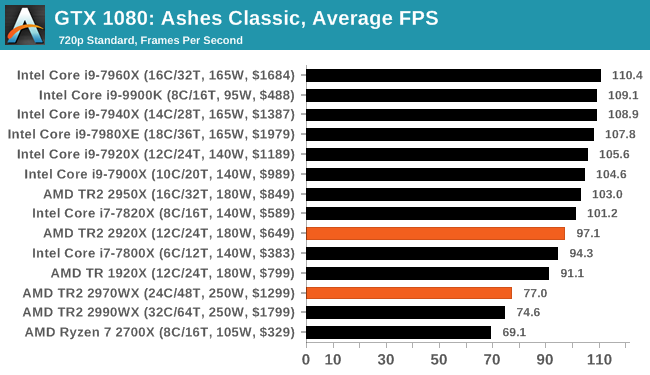 |
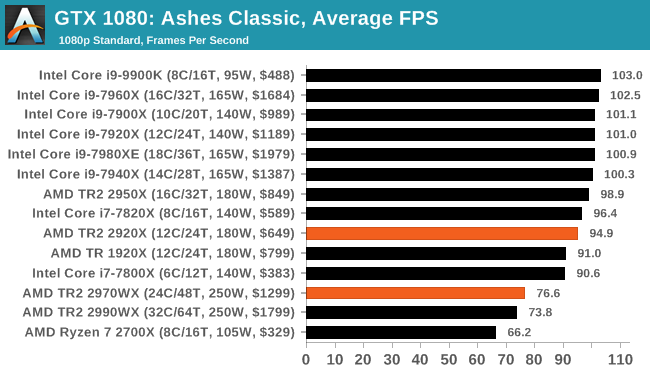 |
 |
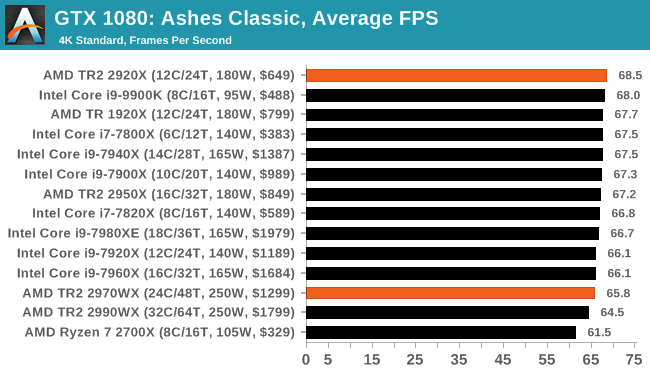 |
| 95th Percentile | 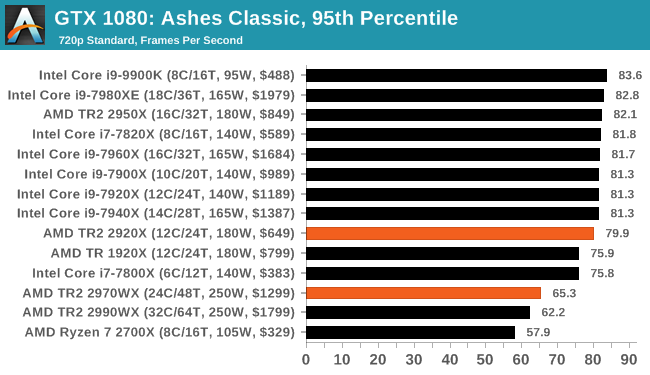 |
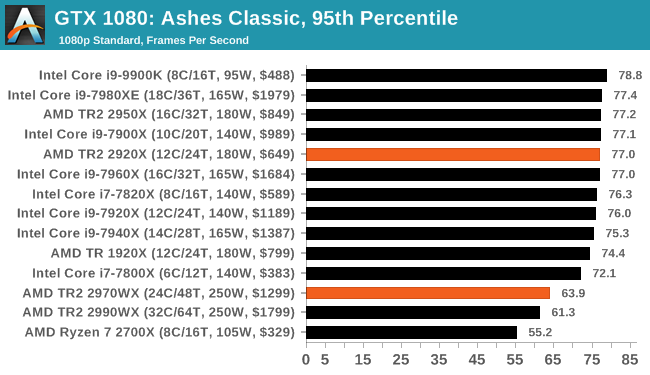 |
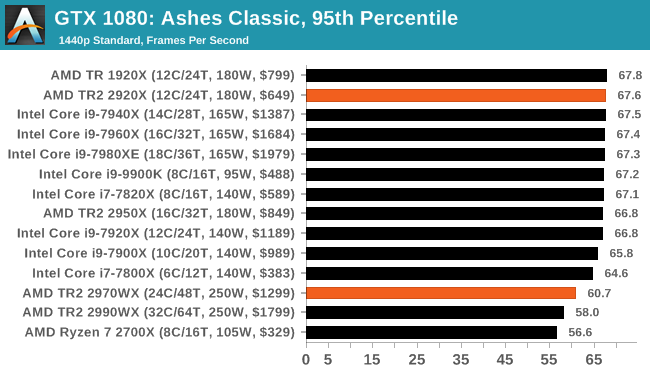 |
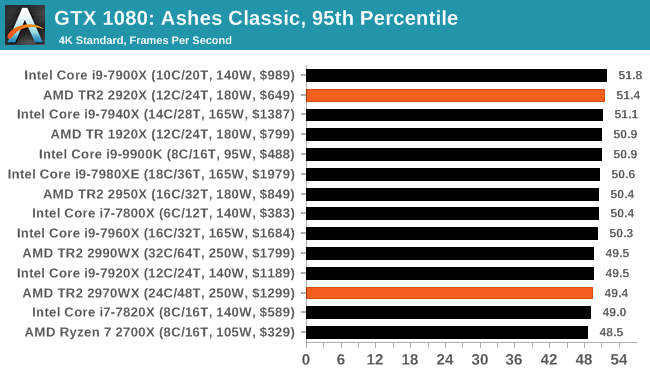 |












69 Comments
View All Comments
The Hardcard - Monday, October 29, 2018 - link
I am not clear on this: can I get a 4-active-die TR for rendering and then turn off the 2 parasite dies when they are a disadvantage. Say make the 2990X operate as a 2950X with the same performance and power?I am not clear if that is what the dynamic local mode is offering. I’d like to be able to do that, whether there is an official AMD path, or if the community finds another way.
BikeDude - Monday, October 29, 2018 - link
<blockquote>Please note, if you plan to share out the Compression graph, please include the Decompression one. Otherwise you’re only presenting half a picture.</blockquote>Many moons ago I made a request to internal IT to adopt 7-zip so that I could save on bandwidth whenever I needed to pull a largish database (this was several years before GDPR obviously).
No go. It turned out that compressing the backups every night eats a lot of time. (decompressing these files was very fast regardless of setup) Well, actually they did use 7z.exe, but only as a normal zipper.
So sometimes the only relevant part of the equation is the compression time. (I do plan on purchasing AMD regardless for my next upgrade)
GreenReaper - Wednesday, October 31, 2018 - link
Use a threading-capable version of xz with the -T parameter so it uses all available threads and you'll find it flies on the default compression settings. It has a Windows version, too: https://tukaani.org/xz/GreenReaper - Wednesday, October 31, 2018 - link
Incidentally, you can probably run it something like xz < "input command" > output.xz, which should mean you don't actually have to write the dumps out, just the compressed version.PaoDeTech - Monday, October 29, 2018 - link
I need 13 cores and 26 threads. Now what? I returned the 32 cores 64 threads one since it could not run FAR CRY at 60fps. But boy could it blend! Sarcasm aside, I write multi-threaded server software and unless I code an infinite loop by mistake (I'm NOT admitting to it) I can never max out 8 threads before hitting I/O limitations (on NVMe PCIe disk). But I can see how some number crunching parallel software would go to town with it.peevee - Wednesday, October 31, 2018 - link
"I can never max out 8 threads before hitting I/O limitations (on NVMe PCIe disk)"Do you know these are IO limitations or do you assume this? Because lack of scaling after 8 threads does not mean IO limit at all. For example, if you write in Java/C#/Python/JS etc (heap-mandatory languages), or even use heap alloc/dealloc in critical thread sections in fast languages like C++, this is what you are going to get (heap mutex = no scalability). And this is just 1 of a thousand pitfalls of massive threading.
PaoDeTech - Thursday, November 1, 2018 - link
No locks, every client call gets its own thread (REST- IIS -WebAPI -.NET "stateless" server - Entity Framework - SQL Server with read committed snapshot isolation). Async all the way down. Under load I can see the disk active >50% and write speed maxes out at 7 MB/s (Toshiba NVMe PCIe 1TB SSD M2). All processes running on the same PC (i7 6700k - 32GB RAM): server, test clients, SQL server. Plenty of free ram.Of course performance optimization is in the details and I was referring to a specific write intensive test case. My point is that parallel scaling is not easy and may stop sooner than expected (for many reasons). On the other hand, I can always use faster single thread performance...
29a - Monday, October 29, 2018 - link
Please replace EgoMark (3DPM) with something else, anything else.danjw - Monday, October 29, 2018 - link
Are there any motherboards out there that support the security features of the Threadripper platform?SLVR - Monday, October 29, 2018 - link
This review is a bit more useful: https://www.techspot.com/review/1737-amd-threadrip...